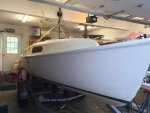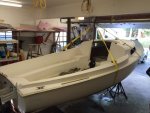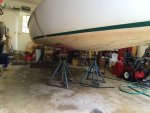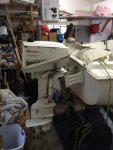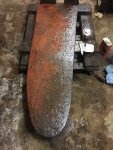UPDATE:
I removed the keel from the boat today. It is held in with a 1/2" bolt at the forward pivot point and then has a cable attached to the rear portion for raising and lowering. The keel is made of iron/steel and tends to rust over its lifetime, which is approaching 40 years. My plan is to refinish the keel and encase it in epoxy & fiberglass so it will last in the salt water and provide good sailing performance.
I used the dolly that I made a few years ago for my 454 engine rebuild. I added a couple of right angle uprights that will guide the keel down from the keel trunk and hold it during restoration. Here is the dolly in place under the keel.
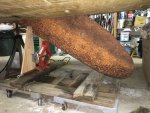
I used a scissor jack to take the weight off of the pivot bolt inside the cabin. I was able to remove the bolt fairly easily. My original plan was to use the scissor jack to lower the keel, but that did not work out too well.
So, I used my 10,000 lb cargo ratchet strap. The keel weights about 170-200 lbs, so not a big deal for the strap. My Catalina 22 had a 500 lb. keel, which I removed and refinished about 12 years ago. Being a lot heavier than this keel, it was more challenging to handle.
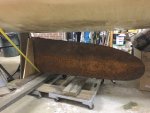
I cut the keel cable, as that will be replaced with the restoration. Then I rolled the keel out from under the boat. Here is the keel on the dolly. You can see the 'water line' in the rust pattern. When the keel is fully raised, it is tucked into the hull and flush with the hull bottom. So the lower 1/2 of the keel stays in the water.
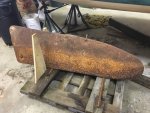
There was not much metal flake on the keel, and for 40 years of age it looked really good. Removing the rust and prepping the keel should be fairly easy based on its condition.
The pivot hole where the bushing goes was in great shape !!! Looks almost new

The bushing itself was in great shape too . .

The hole for the keel cable also looks good.
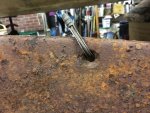
Next steps will be to grind down the rust and prep it for epoxy and encapsulation. While the keel is out, I will also prep the hull bottom for barrier coat and anti-fouling paint.




















